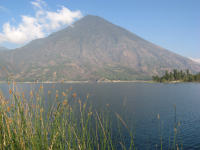
 |
Dona and I wanted to see a little of the Guatemalan highlands. Dave and I had been to Antigua last year, but I'd never been to Lago Atitlan, further north. Our plan was to spend a few days up there, then head to Copan, Honduras, and Quirigua, Guatemala, to see some mayan ruins; and then head to Belize for some sailing. Her flight back was from Belize City.
Dona and I had too much stuff between us. One of the bags she brought down contained a worm-drive saw for a friend of mine. I thought about leaving it at the hotel in Guatemala City, but that meant we had to stop by there on our way back through, and since we only had a few weeks, I was hoping to go from Lake Atitlan clear to Copan, Honduras, in one day on our return. So we lugged the saw around.
I didn't know much about the busses going north from Guatemala City. In fact, I didn't know anything about them, other than that they went. I had arranged for our taxi driver from the day before to pick us up at the hotel. I didn't know which bus lines went north, but I asked him to take us to the bus that went to Lake Atitlan. Unlike the trip east from Guatemala City, where there is primarily only one bus line, there are a boatload of different ones going north. We wanted to go to a town called Santiago Atitlan, not the most common destination up there. Our taxi driver dropped us at a bus station which had Santiago Atitlan written on the front along with other more common destinations. When we inquired if the bus went to Santiago Atitlan, we were told that it went to Panajachel, and we had to take a boat from there. I had a map that showed a road going to Santiago Atitlan; but that didn't necessarily mean a bus went there. I had a sneaky suspicion one did, but not one from this particular bus company. But what the heck, Panajachel is on the lake and a boat ride would be fun, although a bit more money.
Our bus was somewhere between an express bus and a chicken bus. We made pretty good time at first, but as we got into the highlands, we started stopping at more places. The seats filled up, and then the aisles. We were definitely not on a tour bus. At one point we had to stop for some road construction. As usual, vendors came scurrying up to the bus, offering food and newspapers. There were some women with some kind of woven baskets, and since Dona makes baskets, we hopped off to look at them. I'd never seen this kind of basket before, and we hadn't seen any in the big craft market in Guatemala City the day before. It seemed like as good a place as any to buy them, since it wasn't a regular tourist stop. I figured we would see them all over around the lake when we got there, and we'd see whether or not we paid too dearly. But as it turned out, the baskets were somewhat unique. We looked everywhere and talked to other people, and never saw them again. We even had some Guatemalan people ask us where we got them.
The bus kept climbing, and eventually we topped out and started heading down. It was a wonderful, twisty road, and it went down steeply. We stopped in villages along the way; the markets were busy. Unfortunately, we only stopped long enough to eject some people and let others climb in.
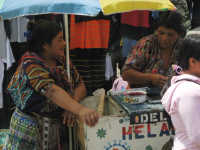 |
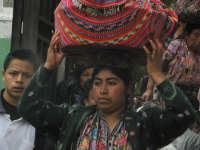 |
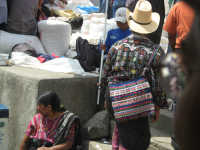 |
 |
| Highlanders |
Guatemala spans Central America from the Pacific to the Atlantic. The North American continental plate and the Pacific plate have to collide here somewhere, and where they do is the land of volcanoes and earthquakes. In the United States we have the San Andreas fault in California (among many others), Mt. Rainier, Mt. St. Helens, Crater Lake, and others. Guatemala is home to numerous volcanoes; Lake Atitlan, Lago Atitlan in Spanish, is hemmed in by three of them. When you finally arrive at the crest and look over and down, it appears that the lake is sitting in the crater of an even older volcano. Panajachel, our bus destination, is one of several small towns situated on the lake. Santiago Atitlan, our final destination, is another.
By the time we got off the bus in Panajachel, our sunny day was starting to cloud up. We hustled our bags through the cobblestone streets and down to the lake, where we hopped on a boat headed for Santiago Atitlan. I had not made any hotel reservations, but Jennifer had told me of a place she liked, Posado de Santiago. It's outside of town, but within walking distance, and on the lake. We had the boat drop us there. Unfortunately, they were full up. Fortunately, they had an arrangement with a neighbor who had a small guest house, and it was available. The arrangement included use of the facilities, which included a pool, hot tub, sauna, and canoes on the lake. Maybe something else too.
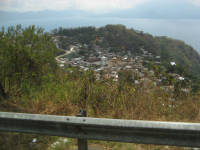 |
 |
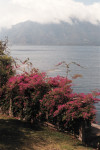 |
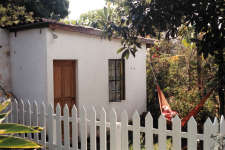 |
| Above Panajachel | Panajachel | Lago Atitlan from
Posado de Santiago |
Our Cottage
|
The people around Lago Atitlan use a kind of boat I've never seen before. They look like an attempt to improve on a cayuco, or dugout, that failed. They are made of planks, and have a straight, blocky shape -- the kind of shape a child would draw, not a naval architect, and not an artist. At least not an artist in harmony with her surroundings. But they appear to work. They have two handles on the back, which may be for carrying them. But the handles have holes in them, so they may be for attaching trolling lines. I forgot to ask.
There were communal washing beaches everywhere, and they were constantly in use. Nearby there was usually another communal boat launching beach.
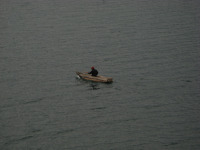 |
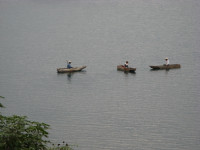 |
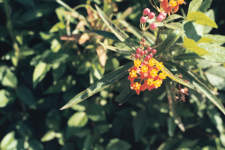 |
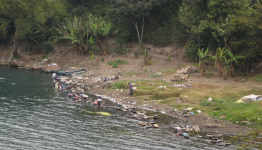 |
| Atitlan boat | Atitlan boats | Flower
|
Wash / Boat Beach |
 |
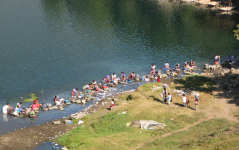 |
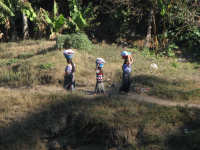 |
| Wash beach |
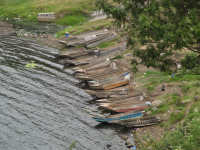 |
| Boats |
Santiago is located on a bay off the main lake, a bay sandwiched between two volcanoes. One rises steeply behind the village (Volcano Toliman, 3,158m), and another rises steeply across the bay (Volcano San Pedro, 3,020m).
 |
 |
| Volcano San Pedro | Beach and Breakwater, Santiago Atitlan |
We had a wonderful dinner to ourselves outside, above the main restaurant in the hotel. We awoke the next morning to a bright sunny day.
 |
| Volcano San Pedro |
We walked into town, where we had one of Dona's rolls of film processed to see if the airport security x-ray had damaged it noticeably. It turned out to be ok. We wandered down to the lake by neighborhood paths, usually narrow streets that turned to cobble sidewalks that turned to dirt paths. Wherever we hit the lake, there was a comunal laundry area and boats up on the beach. We found an area of small subsistance gardens, alongside houses of concrete blocks, sticks, corrugated metal, and whatever else was available.
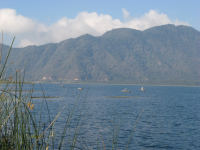 |
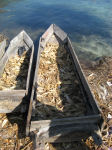 |
 |
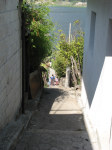 |
| Atitlan | Atitlan Boats | Atitlan Boats and Laundry | Walk to the Beach |
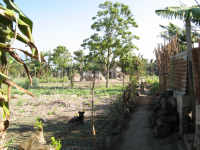 |
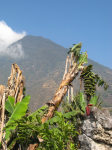 |
| Gardens | Bananas, Volcano San Pedro |
When walking through town, a boy about ten years old asked us if we wanted to see a statue of a Mayan saint. I didn't know such things existed, so we said sure, and followed him up and down and around until we came to a small building that looked like every dwelling around -- rusted tin roof, part cinder block walls, part whatever was available. There was one small room in the tiny structure with a carved statue of a person, a cross between a wooden indian and something else... Buddha? He was smoking some incense or cigarettes, I can't remember which. It was 2 q apiece to view, 10 q for a picture, and I didn't want a picture that badly. There was also a statue / sculpture of Christ, "Santa Christo," laying prone in a case, taken out for the Semana Santa (Holy Week, the last week of Lent) parade once a year. I don't quite understand the name "Santa Christo," since I thought in the Christian faiths Jesus was supposed to be the son of God, not a saint, and I've never heard of a "Saint Christ" in English. Hanging from the ceiling was what looked like Buddhist prayer flags... not. More like they'd cleaned up the side of the road and hung everything they found up there. I couldn't decide if this was legit or a tourist scam, but it was entertaining.
Our walk through town was livened up by the screech of sirens and the blat of a tuba. The volunteer fire department was having a parade. They wound their way through the crowded streets, and somehow didn't run over any of the produce being sold.
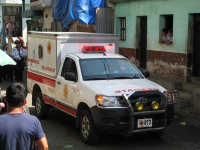 |
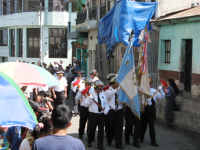 |
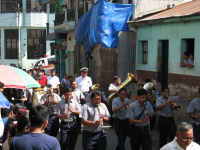 |
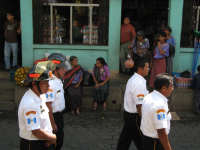 |
| Volunteer firemans' parade | |||
 |
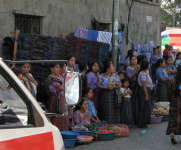 |
||
| Parade watchers | Open market vendors |
Many of the local people get to town on market day, or any other day for that matter, in what I call a "Mayan bus." Take a mini-pickup, add in a stock rack, and then crowd in as many people as can stand. We were amazed at how many that is! I was slow with my picture; two thirds of the people on this one have already gotten out...
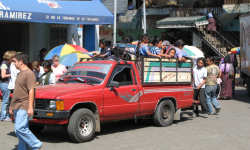 |
| Mayan bus |
The hotel had canoes we could use, so we hopped in one and paddled around our arm of the lake. The wind was blowing a little, but the volcanoes sheltered this narrow arm fairly well. There were many small farms coming down to the lake, with more expensive houses separating them here and there.
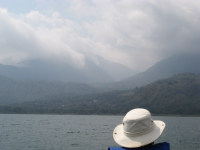 |
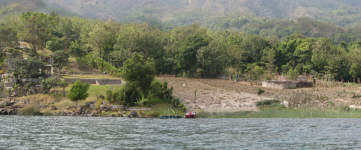 |
| Atitlan by Canoe | Lakeside farms |
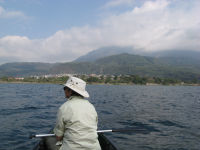 |
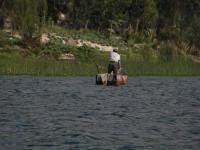 |
| Santiago from lake | Fisherman |
There was a large congregation of people at the place just below our cottage when we came home the first evening, so we asked Martin, the proprietor, what it was all about. We learned that most of these people were displaced by a large mudslide that occurred just around the corner the year before. So we walked up the road to take a look. It wasn't quite what I expected. The jungle was reclaiming ground, as were the villagers. It looked more like flood damage to me than a mudslide, as I couldn't see where things had been covered, and I could clearly see where the creek bed had been eroded. It made you not want to build in the floodplain, or the mudplain, or whatever one calls it. But in a place where all the good land is taken, that's just about everywhere on these steep volcano hillsides, unless you're on a ridgetop. The gathering of people was to discuss ways to try to get more disaster help from the government.
 |
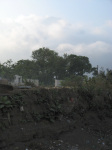 |
| Post mudslide reconstruction | Mudslide cut in creek |
We hiked up through the village that had been destroyed, and came to a coffee plantation above it. I was amazed at the expanse of it when I thought of the labor required to cultivate a plantation on these steep hillsides. This was not shade-grown coffee, and the laborers did not appear to be very well paid.
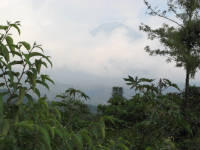 |
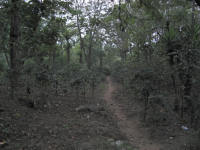 |
| Coffee Plantation, Volcano Toliman | Coffee Plantation |
The next day we headed for Copan, Honduras, to see some Mayan ruins. This time, we took the bus. We started from Santiago Atitlan, and our chicken bus was designed to be stuffed full, three to a bench seat on each side. The isle was maybe a foot wide. After a few stops, it was full. The road out was great fun, winding up and down and around. It would have been a kick in the pants on a small motorcycle. The lake was a delight to see in the distance. The trip to Guatemala city took about four hours, and cost 30q (quetzales), about $4. Quite a bit less than our boat ride across the lake...
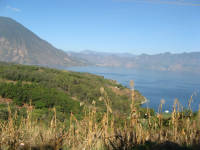 |
 |
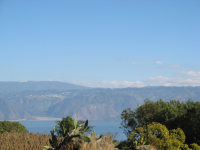 |
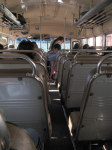 |
| Lago Atitlan | Road from Santiago | Lago Atitlan | Chicken bus |